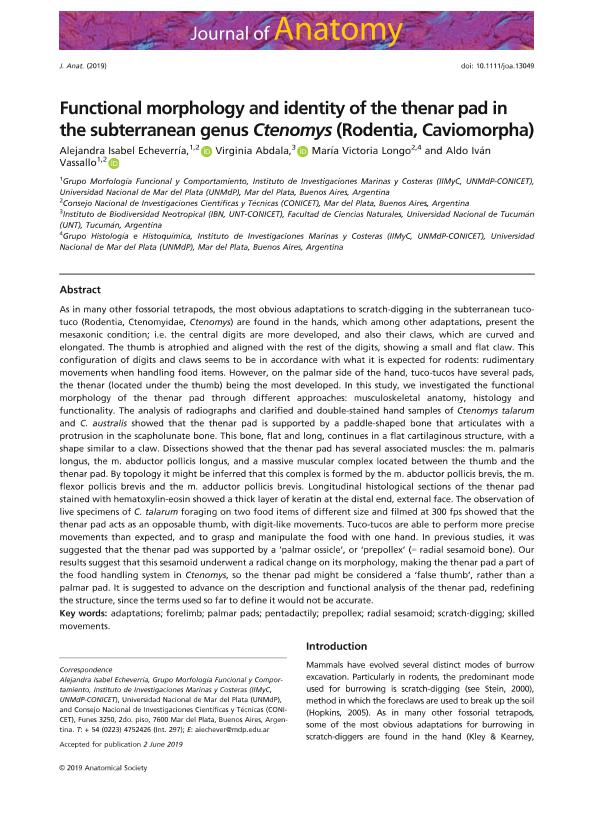Mostrar el registro sencillo del ítem
dc.contributor.author
Echeverría, Alejandra Isabel

dc.contributor.author
Abdala, Virginia Sara Luz

dc.contributor.author
Longo, María Victoria

dc.contributor.author
Vassallo, Aldo Iván

dc.date.available
2020-12-09T16:05:15Z
dc.date.issued
2019-11
dc.identifier.citation
Echeverría, Alejandra Isabel; Abdala, Virginia Sara Luz; Longo, María Victoria; Vassallo, Aldo Iván; Functional morphology and identity of the thenar pad in the subterranean genus Ctenomys (Rodentia, Caviomorpha); Wiley Blackwell Publishing, Inc; Journal of Anatomy; 235; 5; 11-2019; 940-952
dc.identifier.issn
0021-8782
dc.identifier.uri
http://hdl.handle.net/11336/119984
dc.description.abstract
As in many other fossorial tetrapods, the most obvious adaptations to scratch-digging in the subterranean tuco-tuco (Rodentia, Ctenomyidae, Ctenomys) are found in the hands, which among other adaptations, present the mesaxonic condition; i.e. the central digits are more developed, and also their claws, which are curved and elongated. The thumb is atrophied and aligned with the rest of the digits, showing a small and flat claw. This configuration of digits and claws seems to be in accordance with what it is expected for rodents: rudimentary movements when handling food items. However, on the palmar side of the hand, tuco-tucos have several pads, the thenar (located under the thumb) being the most developed. In this study, we investigated the functional morphology of the thenar pad through different approaches: musculoskeletal anatomy, histology and functionality. The analysis of radiographs and clarified and double-stained hand samples of Ctenomys talarum and C. australis showed that the thenar pad is supported by a paddle-shaped bone that articulates with a protrusion in the scapholunate bone. This bone, flat and long, continues in a flat cartilaginous structure, with a shape similar to a claw. Dissections showed that the thenar pad has several associated muscles: the m. palmaris longus, the m. abductor pollicis longus, and a massive muscular complex located between the thumb and the thenar pad. By topology it might be inferred that this complex is formed by the m. abductor pollicis brevis, the m. flexor pollicis brevis and the m. adductor pollicis brevis. Longitudinal histological sections of the thenar pad stained with hematoxylin-eosin showed a thick layer of keratin at the distal end, external face. The observation of live specimens of C. talarum foraging on two food items of different size and filmed at 300 fps showed that the thenar pad acts as an opposable thumb, with digit-like movements. Tuco-tucos are able to perform more precise movements than expected, and to grasp and manipulate the food with one hand. In previous studies, it was suggested that the thenar pad was supported by a ‘palmar ossicle’, or ‘prepollex’ (= radial sesamoid bone). Our results suggest that this sesamoid underwent a radical change on its morphology, making the thenar pad a part of the food handling system in Ctenomys, so the thenar pad might be considered a ‘false thumb’, rather than a palmar pad. It is suggested to advance on the description and functional analysis of the thenar pad, redefining the structure, since the terms used so far to define it would not be accurate.
dc.format
application/pdf
dc.language.iso
eng
dc.publisher
Wiley Blackwell Publishing, Inc

dc.rights
info:eu-repo/semantics/openAccess
dc.rights.uri
https://creativecommons.org/licenses/by-nc-sa/2.5/ar/
dc.subject
ADAPTATIONS
dc.subject
FORELIMB
dc.subject
PALMAR PADS
dc.subject
PENTADACTILY
dc.subject
PREPOLLEX
dc.subject
RADIAL SESAMOID
dc.subject
SCRATCH-DIGGING
dc.subject
SKILLED MOVEMENTS
dc.subject.classification
Zoología, Ornitología, Entomología, Etología

dc.subject.classification
Ciencias Biológicas

dc.subject.classification
CIENCIAS NATURALES Y EXACTAS

dc.title
Functional morphology and identity of the thenar pad in the subterranean genus Ctenomys (Rodentia, Caviomorpha)
dc.type
info:eu-repo/semantics/article
dc.type
info:ar-repo/semantics/artículo
dc.type
info:eu-repo/semantics/publishedVersion
dc.date.updated
2020-11-26T17:50:23Z
dc.journal.volume
235
dc.journal.number
5
dc.journal.pagination
940-952
dc.journal.pais
Reino Unido

dc.journal.ciudad
Londres
dc.description.fil
Fil: Echeverría, Alejandra Isabel. Consejo Nacional de Investigaciones Científicas y Técnicas. Centro Científico Tecnológico Conicet - Mar del Plata. Instituto de Investigaciones Marinas y Costeras. Universidad Nacional de Mar del Plata. Facultad de Ciencias Exactas y Naturales. Instituto de Investigaciones Marinas y Costeras; Argentina
dc.description.fil
Fil: Abdala, Virginia Sara Luz. Consejo Nacional de Investigaciones Científicas y Técnicas. Centro Científico Tecnológico Conicet - Tucumán. Instituto de Biodiversidad Neotropical. Universidad Nacional de Tucumán. Facultad de Ciencias Naturales e Instituto Miguel Lillo. Instituto de Biodiversidad Neotropical. Instituto de Biodiversidad Neotropical; Argentina
dc.description.fil
Fil: Longo, María Victoria. Consejo Nacional de Investigaciones Científicas y Técnicas. Centro Científico Tecnológico Conicet - Mar del Plata. Instituto de Investigaciones Marinas y Costeras. Universidad Nacional de Mar del Plata. Facultad de Ciencias Exactas y Naturales. Instituto de Investigaciones Marinas y Costeras; Argentina
dc.description.fil
Fil: Vassallo, Aldo Iván. Consejo Nacional de Investigaciones Científicas y Técnicas. Centro Científico Tecnológico Conicet - Mar del Plata. Instituto de Investigaciones Marinas y Costeras. Universidad Nacional de Mar del Plata. Facultad de Ciencias Exactas y Naturales. Instituto de Investigaciones Marinas y Costeras; Argentina
dc.journal.title
Journal of Anatomy

dc.relation.alternativeid
info:eu-repo/semantics/altIdentifier/doi/http://dx.doi.org/10.1111/joa.13049
dc.relation.alternativeid
info:eu-repo/semantics/altIdentifier/url/https://onlinelibrary.wiley.com/doi/abs/10.1111/joa.13049
Archivos asociados
